2020 MERCEDES-BENZ GLA wheel
[x] Cancel search: wheelPage 47 of 346
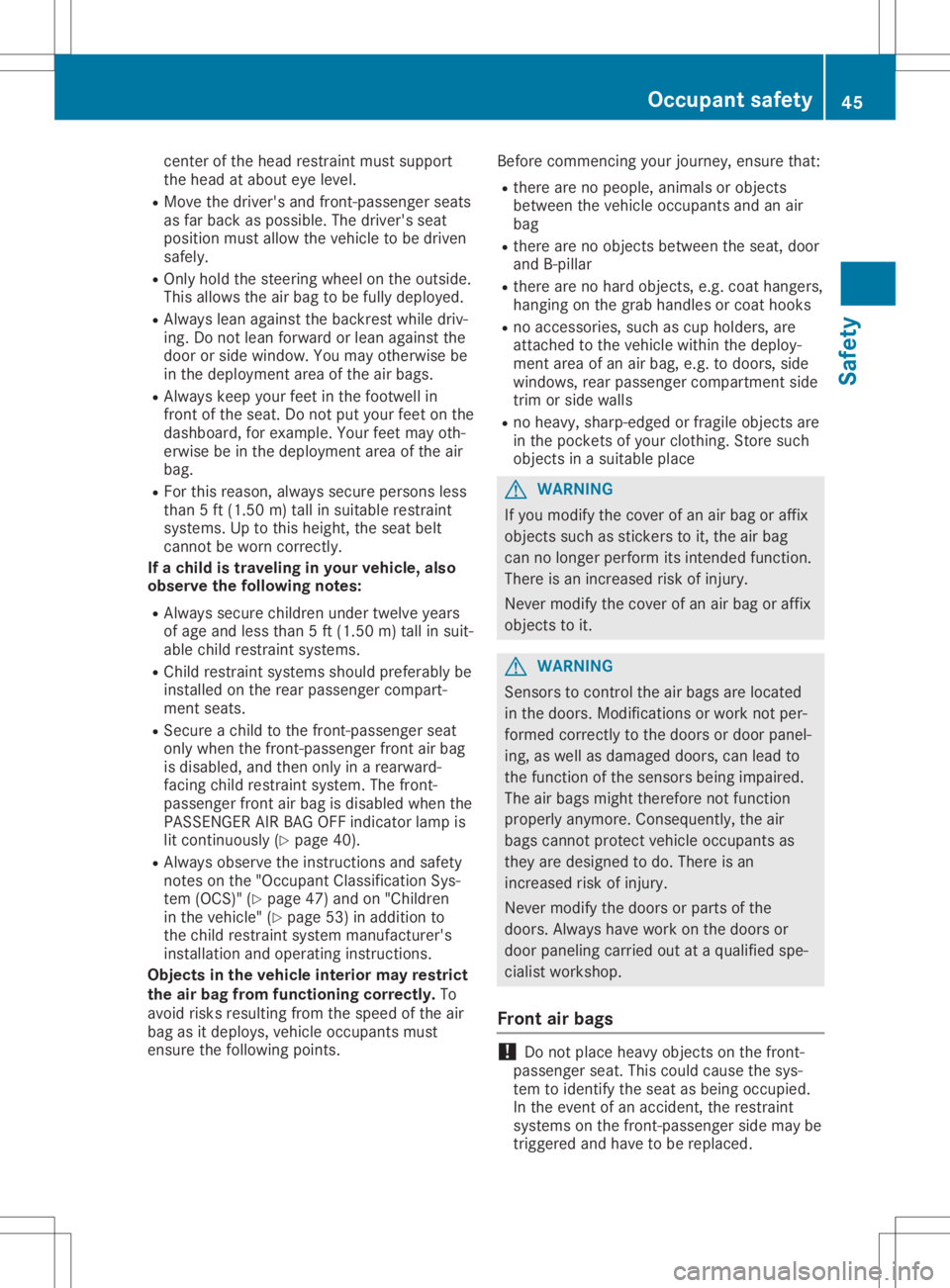
center
ofthe headrestra intmus tsu ppo rt
the headat abou tey elevel .
R Move thedriver' sand front-pa ssenger seats
as far back aspos sible.The driver' ssea t
pos ition mus tal low thevehi cletobe driven
saf ely.
R Only holdthe stee ring wheelon the outsid e.
Thi sal low sthe airba gto be fullydep loyed.
R Alw aysle an against the backrest whiledri v-
ing. Donot lean forw ardorlean against the
doo ror sid ewi ndow .You may otherwisebe
in the deployment areaof the airba gs.
R Alw ayskeep your fee tin the footw ellin
front ofthe seat.Do not putyo ur fee ton the
da shb oard, for exa mpl e.You rfee tmay oth-
erw isebeinthe deployment areaof the air
ba g.
R For this reason, alwa yssecu reper sons less
than 5ft (1.50 m)tallin suita ble res traint
sy ste ms. Uptothishe ight, the seat belt
cann otbe worncorr ectly.
If ach ild is trave ling inyour vehic le,als o
ob serve the follow ingno tes :
R Alw aysse cur echi ldren undertwe lveyears
of ageand less tha n5 ft (1.5 0m) tallin suit-
ab lechi ldres traint syste ms.
R Ch ild res traint syste ms should pre ferablybe
ins talled on the rearpa sse nge rcomp art-
ment seats .
R Secu reachi ldto the front-pa ssenge rse at
onl ywh en the front-pa ssenge rfro ntairba g
is disa bled ,and thenonl yin area rward-
fa cing childres traint syste m. The front-
pa sse nge rfro ntairba gis disa bled when the
PASSEN GERAIRBAG OFFindicator lamp is
li t conti nuously(Y page 40).
R Alw aysob serve the instructio nsand safety
note son the "Occu pant Clas sific ati on Sys -
tem (OCS) "(Y page 47) and on"Child ren
in the vehicle" (Y page 53)in ad ditio nto
the childres traint syste mma nuf actu rer's
ins tallatio nand opera ting instructio ns.
Ob jec tsinthe vehic leinteri ormay restric t
the airbag fromfun ctioningco rrec tly.To
av oid ris ks res ulting fromthe spee dof the air
ba gas itde ploy s,veh icleoccu pants must
ens urethe followi ng points . Befo
recomm encingyour jou rney ,ens uretha t:
R the reareno peop le,ani ma lsor objects
be twe enthe vehicleoccu pants and anair
ba g
R the reareno objects betwe enthe seat, door
and B-pillar
R the reareno hard objects ,e.g .coa tha nge rs,
ha ngi ng on the grabha ndl esorcoa thoo ks
R no acc essor ies, su ch ascup holders, are
atta chedto the vehiclewi thi nthe deploy -
ment area ofan airba g,e.g .to doors ,si de
wi ndo ws,rea rpa sse nge rcomp artment side
trim orside walls
R no heavy, sha rp-e dged orfra gile ob jects are
in the pockets ofyour clo thing. Store such
ob jects inasu ita ble place G
WA
RNING
If yo umod ifythe cove rof an airba gor affix
ob jects such assticker sto it,the airba g
can nolonge rpe rfo rm itsinte ndedfu nctio n.
The reisan incr easedris kof inju ry.
Nev ermod ifythe cove rof an airba gor affix
ob jects toit. G
WA
RNING
Sens orstocontro lthe airba gs arelocate d
in the doors .Mod ificati ons orwo rknot per-
for med correctlyto the doors ordoor panel -
ing ,as wellas dama geddo ors ,can lead to
the functio nof the senso rsbeing impaire d.
The airba gs might therefore not functio n
pro perly any mor e.Co nse quentl y,the air
ba gs cann otpro tect vehicleoccu pants as
the yar ede signe dto do.The reisan
incr easedris kof inju ry.
Nev ermod ifythe doors orparts ofthe
do ors .Alw aysha ve workon the doors or
do or panel ing carriedou tat aqu alifi ed spe-
cia list wo rksh op.
Fro ntair bag s !
Do
not place heavyob jects onthe front-
pa sse nge rse at. Thiscou ldcau sethe sys-
tem toidenti fythe seat as being occu pied .
In the eventofan acc ident, therestraint
sy ste ms onthe front-pa ssenge rsi de maybe
trig gered and have tobe rep laced . Oc
cupant safety
45Safety Z
Page 63 of 346

the
stop ping dista nce onoff-roa dterr ain. Thi s
li mi ts ste ering cap ability . BAS
(Brak eAs sist Sys tem)
Ge neral info rmatio n BAS
opera tes ineme rgency braking situa tions.
If yo ude pre ssthe brakepedalqu ickl y,BAS
au toma tically bo osts thebraking force, thus
sho rteni ngthe stop ping dista nce.
Impo rtant safety notes i
Ob
serve the "Impo rtantsafety note s"sec-
tio n(Y page 60) . G
WA
RNING
If BAS isma lfunctio ning,the braking dis-
tance inan eme rgency braking situa tionis
incr eased. The reisaris kof an acc ident.
In an eme rgency braking situa tion,de pre ss
the brakepedalwi th fullfor ce. ABS prevents
the wheelsfro mlocking .
Braki ng X
Kee pthe brakepedalfir ml yde pre sse dunti l
the eme rgency braking situa tionis ove r.
ABS prevents thewheelsfro mlocking .
The brakes willfu nctio nas usua lonce you
rel ease the brakepedal.BAS isde acti vated . Ac
tiv eBrake Assist
Ge neral info rmatio n i
Ob
serve the "Impo rtantsafety note s"sec-
tio n(Y page 60).
Activ eBra keAssi stcons ists of adi sta nce
wa rning functio nwi th an autono mousbra king
fu nctio nand asitua tion-de pende ntbra ke
bo osti ngeffect.
Activ eBra keAssi stcan helpyouto minim ize
the riskof acol lisi on with the vehicletra vel ing
in fro ntor red uce theeffects ofsuch acol li-
si on.
If Activ eBra keAssi stdetects thatthe reisa
ris kof col lisi on, youwi llbe warned visually
and acoustica lly. Ifyo udo not reactto the vis- ua
lcol lisi on warning orthe warning tone ,
au tono mousbra king canbeinitia ted incri tica l
si tua tions. Ifyo uap plythe brakeyourse lfin a
cri tica lsi tua tion,Activ eBra keAssi stsupp orts
yo uwi th asitua tion-de pende ntbra keboosti ng
eff ect.
Impo rtant safety notes Dete
ctionof hazar dous situa tions can bepar-
ticu larly impaire dif:
R Th ere isdirt on the senso rsor any thing else
cove ringthe senso rs
R Th ere issno wor heavyra in
R Th ere isinte rferenc eby othe rra da rsou rces
R Th ere arestro ngrada rref lectio ns,forexa m-
pl e in pa rki ng garage s
R Anar row vehicleis tra vel ing infro nt, e.g.a
moto rbike
R Aveh icleis tra vel ing infro nton adi ffe rent
li ne
R Yo uar edri vin ganew vehicleor servi cing on
the Activ eBra keAssi stsyste mhasjus t
be en car riedou t
Ob serve the impo rta ntsafety note sin the
"Br eaking -innote s"sectio n(Y page 124) .
Fol lowi ng dama getothe frontend ofthe vehi-
cle ,ha ve the confi guratio nand opera tionof
the rada rse nso rche cked ataqu alifi ed spe-
cia list wo rksh op.Th isalso appliesto col lisi ons
at low sp ee ds where novisible da ma getothe
fro ntofthe vehicleis ap parent.
Ac tiv atin g/dea ctivati ng Activ
eBra keAssi stisacti veafter eve ryigni-
tio ncy cle .
Yo ucan activate or deacti vate Activ eBra ke
Assi st(Y page 197 )in the on-b oard com-
pu ter. Whendeacti vated ,the dista nce warning
fu nctio nand theautono mousbra king functio n
ar ealso deacti vated .
If Activ eBra keAssi stisde acti vated ,the 00D4
sy mbo lap pe arsin the assista nce graphicdis-
pl ay .
If yo uha ve acti vated DSR, ActiveBra keAssi st
is de acti vated .For furthe rinf orm ation onDSR,
se e(Y page 169 ). Dr
ivi ng safet ysy stem s
61Safet y Z
Page 65 of 346
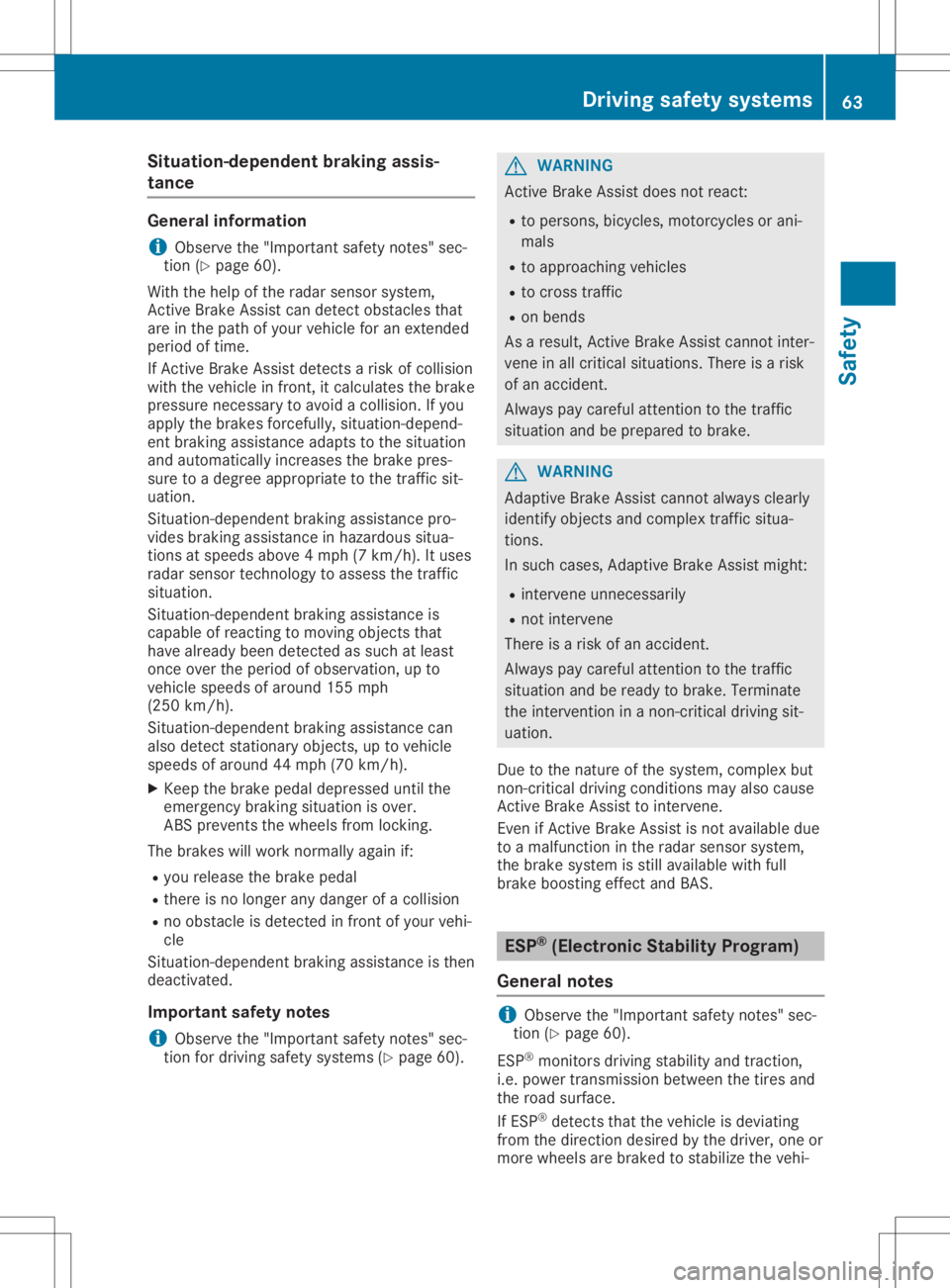
Situat
ion-dependent brakingassis-
tance General
informat ion
i Observe
the"Important safetynotes" sec-
tion (Ypage 60).
With thehelp ofthe radar sensor system,
Act ive Brake Assist candetect obstacles that
are inthe path ofyour vehicle foranexten ded
period oftime.
If Act ive Brake Assist detectsa risk ofcollision
with thevehicle infront ,it calculates thebrake
pressure necessary toavoid acollision. Ifyou
apply thebrakes forcefully, <0056004C0057005800440057004C005200510010004700480053004800510047
0010[
ent braking assistance adaptstothe situation
and automatically increasesthebrake pres-
sure toadegree appropriate tothe traffic sit-
uation.
Situation- dependent brakingassistance pro-
vides braking assistance inhazardous situa-
tions atspeeds above4mph (7km/h). Ituses
radar sensor technology toassess thetraffic
situation.
Situation- dependent brakingassistance is
capable ofreacting tomoving objectsthat
have already beendetect edassuch atleast
once overtheperiod ofobservation, upto
vehicle speeds ofaround 155mph
(250 km/h).
Situation- dependent brakingassistance can
also detect stationary objects,up tovehicle
speeds ofaround 44mph (70km/h).
X Keep thebrake pedaldepressed untilthe
emergency brakingsituation isover.
ABS prevent sthe wheels fromlocking.
The brakes willwork normally againif:
R you release thebrake pedal
R there isno longer anydanger ofacollision
R no obstacle isdetect edinfront ofyour vehi-
cle
Situation- dependent brakingassistance isthen
deactivated.
Import antsafety notes
i Observe
the"Important safetynotes" sec-
tion fordriving safetysystems (Ypage 60). G
WARNING
Act ive Brake Assist doesnotreact:
R to persons, bicycles, motorcyclesorani-
mals
R to approaching vehicles
R to cross traffic
R on bends
As aresult, Active Brake Assist cannot inter-
vene inall critical situations. Thereisarisk
of an accident.
Always paycareful attentiontothe traffic
situation andbeprepared tobrake. G
WARNING
Adaptive BrakeAssist cannot alwaysclearly
identify objectsand complex trafficsitua-
tions.
In such cases, Adaptive BrakeAssist might:
R interv eneunnecessarily
R not interv ene
There isarisk ofan accident.
Always paycareful attentiontothe traffic
situation andbeready tobrake. Terminate
the interv ention inanon- critical drivingsit-
uation.
Due tothe nature ofthe system, complex but
non- critical drivingcondition smay alsocause
Act ive Brake Assist tointerv ene.
Even ifAct ive Brake Assist isnot availa bledue
to amalfunction inthe radar sensor system,
the brake system isstill availa blewith full
brake boosting effectandBAS. ESP
®
(Ele ctronic Stability Program)
General notes i
Observe
the"Important safetynotes" sec-
tion (Ypage 60).
ESP ®
monitor sdriving stability andtract ion,
i.e. power transm issionbetween thetires and
the road surface.
If ESP ®
detect sthat thevehicle isdeviating
from thedirection desiredbythe driver, oneor
more wheels arebraked tostabilize thevehi- Driving
safetysystems
63Safety Z
Page 67 of 346
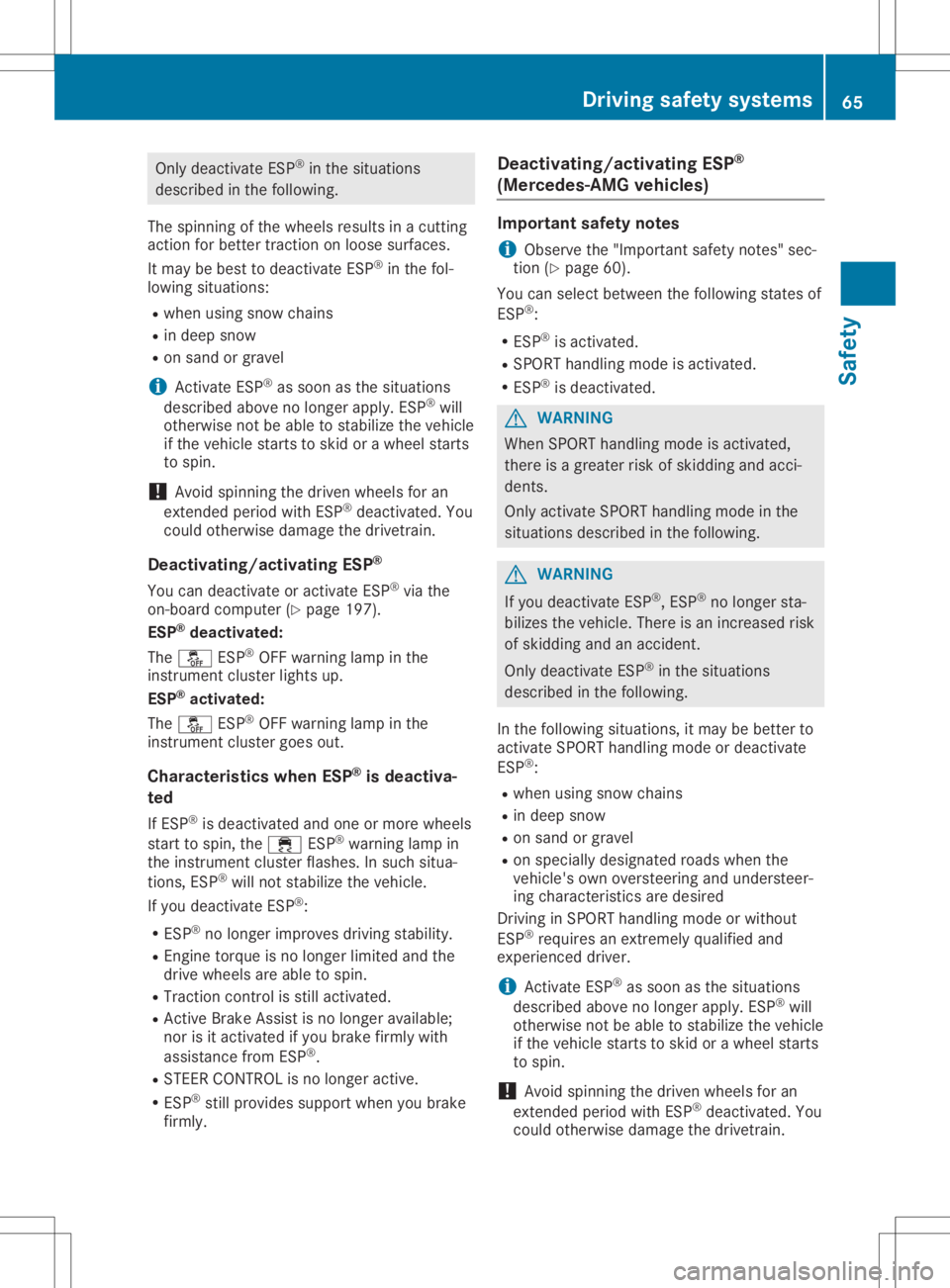
Only
deactivate ESP®
in the situations
described inthe followi ng.
The spinning ofthe wheels resultsinacutting
action forbetter traction onloose surfaces.
It may bebest todeactivate ESP®
in the fol-
lowing situations:
R when usingsnowchains
R in deep snow
R on sand orgravel
i Act
ivate ESP®
as soon asthe situations
described abovenolonger apply.ESP ®
will
otherwise notbeable tostabilize thevehicle
if the vehicle startstoskid orawheel starts
to spin.
! Avoid
spinning thedriven wheels foran
extended periodwithESP®
deactivated. You
could otherwise damagethedrivetrain.
Deactivating/ activatingESP®
You candeactivate oractivate ESP®
via the
on-board computer (Ypage 197).
ESP ®
deactivated:
The 00BB ESP®
OFF warning lampinthe
instrument clusterlightsup.
ESP ®
activated:
The 00BB ESP®
OFF warning lampinthe
instrument clustergoesout.
Characteristics whenESP®
is deactiva-
ted
If ESP ®
is deactivated andone ormore wheels
start tospin, the00E5 ESP®
warning lampin
the instrument clusterflashes. Insuch situa-
tions, ESP®
will notstabilize thevehicle.
If you deactivate ESP®
:
R ESP ®
no longer improves drivingstability.
R Engine torqueisno longer limited andthe
drive wheels areable tospin.
R Traction controlisstill activated.
R Act ive Brake Assist isno longer available;
nor isitactivated ifyou brake firmlywith
assistance fromESP®
.
R STEE RCONTROL isno longer active.
R ESP ®
still provides supportwhenyoubrake
firmly. Deac
<0057004C005900440057004C0051004A0012004400460057004C005900440057
004C0051004A> ESP®
(Mercedes‑AMG vehicles) Importa
ntsafety notes
i Observe
the"Important safetynotes" sec-
tion (Ypage 60).
You canselect between thefollowi ngstates of
ESP ®
:
R ESP ®
is activated.
R SPORT handling modeisactivated.
R ESP ®
is deactivated. G
WARNING
When SPORT handling modeisactivated,
there isagreater riskofskidding andacci-
dents.
Only activate SPORThandling modeinthe
situations described inthe followi ng. G
WARNING
If you deactivate ESP®
,ESP ®
no longer sta-
bilizes thevehicle. Thereisan increased risk
of skidding andanaccident.
Only deactivate ESP®
in the situations
described inthe followi ng.
In the followi ngsituations, itmay bebetter to
activate SPORThandling modeordeactivate
ESP ®
:
R when usingsnowchains
R in deep snow
R on sand orgravel
R on speciall ydesignated roadswhenthe
vehicle's ownoversteering andundersteer-
ing characteristics aredesired
Driving inSPORT handling modeorwithout
ESP ®
requires anextremely qualified and
experienced driver.
i Act
ivate ESP®
as soon asthe situations
described abovenolonger apply.ESP ®
will
otherwise notbeable tostabilize thevehicle
if the vehicle startstoskid orawheel starts
to spin.
! Avoid
spinning thedriven wheels foran
extended periodwithESP®
deactivated. You
could otherwise damagethedrivetrain. Driving
safetysystems
65Safety Z
Page 69 of 346

swerving.
Trailerswithahigh centerofgrav-
ity can tipover before ESP®
can detect this.
There isarisk ofan accident.
Always adaptyour driving styletothe pre-
vailing roadandweather conditions.
If your vehicle withtrailer (vehicle/trailer com-
bination) beginstolurch, youcan only stabilize
the vehicle/trailer combinationbydepressing
the brake firmly.
ESP ®
trailer stabilization isactive above
speeds ofabout 65km/h.
ESP ®
trailer stabilization doesnotwork if
ESP ®
is deactivated ordisabl edbecause ofa
malfunction. EBD
(electronic brakeforcedistribu-
tion)
General informat ion EBD
monitors andcont rolsthebrake pressure
on the rear wheels toimprove drivingstability
while braking.
Importa ntsafety notes i
Observe
the"Important safetynotes" sec-
tion (Ypage 60). G
WARNING
If EBD ismalfunctioning, therear wheels can
lock, e.g.under fullbraking. Thisincreases
the risk ofskidding andanaccident.
You should therefore adaptyour driving
style tothe different handling characteris-
tics. Have thebrake system checked ata
qual ified speciali stworkshop.
Please observe theinformation onwarning
and indicator lamps(Ypage 234)
(Y page 234)aswell ason displa ymessages
(Y page 207). ADA
PTIVE BRAKE
ADA PTIVE BRAKE enhances brakingsafetyand
offers increased brakingcomfort.In addition
to the braking function, ADAPTIVE BRAKE also has
theHOLD function (Ypage 165)andhill
start assist (Ypage 128). STEER
CONTROL
General informat ion STEE
RCONTROL helpsyoubytransmitt inga
noticeable steeringforcetothe steering wheel
in the direction requiredforvehicle stabiliza-
tion.
This steering assistance isprovided inparticu-
lar if:
R both right wheels orboth leftwheels areon
a wet orslippery roadsurface whenyou
brake
R the vehicle beginstoskid
Importa ntsafety notes i
Observe
the"Important safetynotes" sec-
tion (Ypage 60).
No steering assistance isprovided fromSTEER
CONTROL, if:
R ESP ®
is malfunctioning
R the steering ismalfunctioning
If ESP ®
is malfunctioning, youwillbeassisted
further bythe electrical powersteering. Protection
againsttheft Immobilizer
The immobili zerprevents yourvehicle from
being started without thecorrect SmartKey.
X To activate withtheSmar tKey: remove
the SmartKey fromtheignition lock.
X To
activate withKEYLESS-GO start-func-
tion orKEY LESS-GO: switchtheignition off
and open thedriver's door.
X To deactivate: switchonthe ignition.
When leaving thevehicle, alwaystake the
SmartKey withyouand lock thevehicle. Any-
one canstart theengine ifavalid SmartKey
has been leftinside thevehicle.
i The
immobili zerisalwa ysdeactivated
when youstart theengine.
In the event thattheengine cannot bestar-
ted (yet thevehicle's batteryischarged), Protection
againsttheft
67Safety Z
Page 78 of 346

X
To unl ock: pre ssbutton 0043.
X To lock :pre ssbutton 0044.
If allthe doors and thetailgate are closed ,
the vehiclelocks.
Mea nwhile, the fuelfil lerfla pwi llnot be
lo cked orunl ocke d.
Yo ucanno tunl ock thevehiclecentra lly from
the inside if the vehicleha sbe en locked with
the Sma rtKey orKEYL ESS-GO .
Yo ucan open ado or from inside the vehicle
eve nif it ha sbe en locked .Yo ucan open the
rea rdo ors from inside the vehicleunl ess they
are secu redbythe child-pro oflock
(Y page 59).
If the vehicleha spre viouslybe en locked with
the Sma rtKey fromtheoutsid e,op eni ng ado or
from theinside wi lltrig ger the anti-thef tal arm
sy stem .Swi tch offthe alarm (Ypage 68).
If alocked door isop ene dfrom theinside, the
pre vious unl ock status ofthe vehiclewi llbe
take ninto consi derati onif:
R the vehiclewa slo cked using the locking
bu tton forthe centra llo cking ,or
R ifthe vehiclewa slo cked automa tically
The vehiclewi llbe fullyunl ocke difit ha dpre -
vio uslybe en fullyunl ocke d.Ifonl ythe driver' s
do or hadbe en pre viouslyunl ocke d,onl ythe
do or wh ich hasbe en opene dfrom theinside is
unl ocke d. Au
tomati clo ck ingfea ture X
To deac tivate: pressand holdbu tton 0043for
ap pro xima telyfiv eseco ndsuntila tone
sou nds.
X To acti vate :pre ssand holdbu tton 0044for
ap pro xima telyfiv eseco ndsuntila tone
sou nds.
If yo upre ssone ofthe two buttons anddonot
hea ra tone, thereleva ntsetti nghasal rea dy
be en selecte d.
The vehicleis locked automa tically wh en the
ig niti onissw itch edon and thewheelsare
turni ng.
Yo ucou ldther eforelock yoursel fou tif:
R the vehicleis be ing pushe d
R the vehicleis be ing tow ed
R the vehicleis on arol lerdy nam ome ter
Yo ucan also switch theautoma ticlocking
func tionon and offusing the on-b oard com-
pu ter (Ypage 199 ). Un
lock ingthe drive r'sdoo r(me chan-
ic al key )
If the vehiclecan nolonger belocked or
unl ocke dwi th the Sma rtKey orKEYL ESS-GO ,
us ethe mech anical key.
If yo uus ethe mech anical key tounl ock and
op en the driver' sdo or, the anti-thef tal arm
sy stem willbe trig gered.Swi tch offthe alarm
(Y page 68).
X Take the mech anical key outof the Sma rt-
Key (Ypage 71).
X Inse rtthe mech anical key into thelock of
the driver' sdo or as far asitwi llgo. 76
Do
orsOpe ning and clos ing
Page 94 of 346
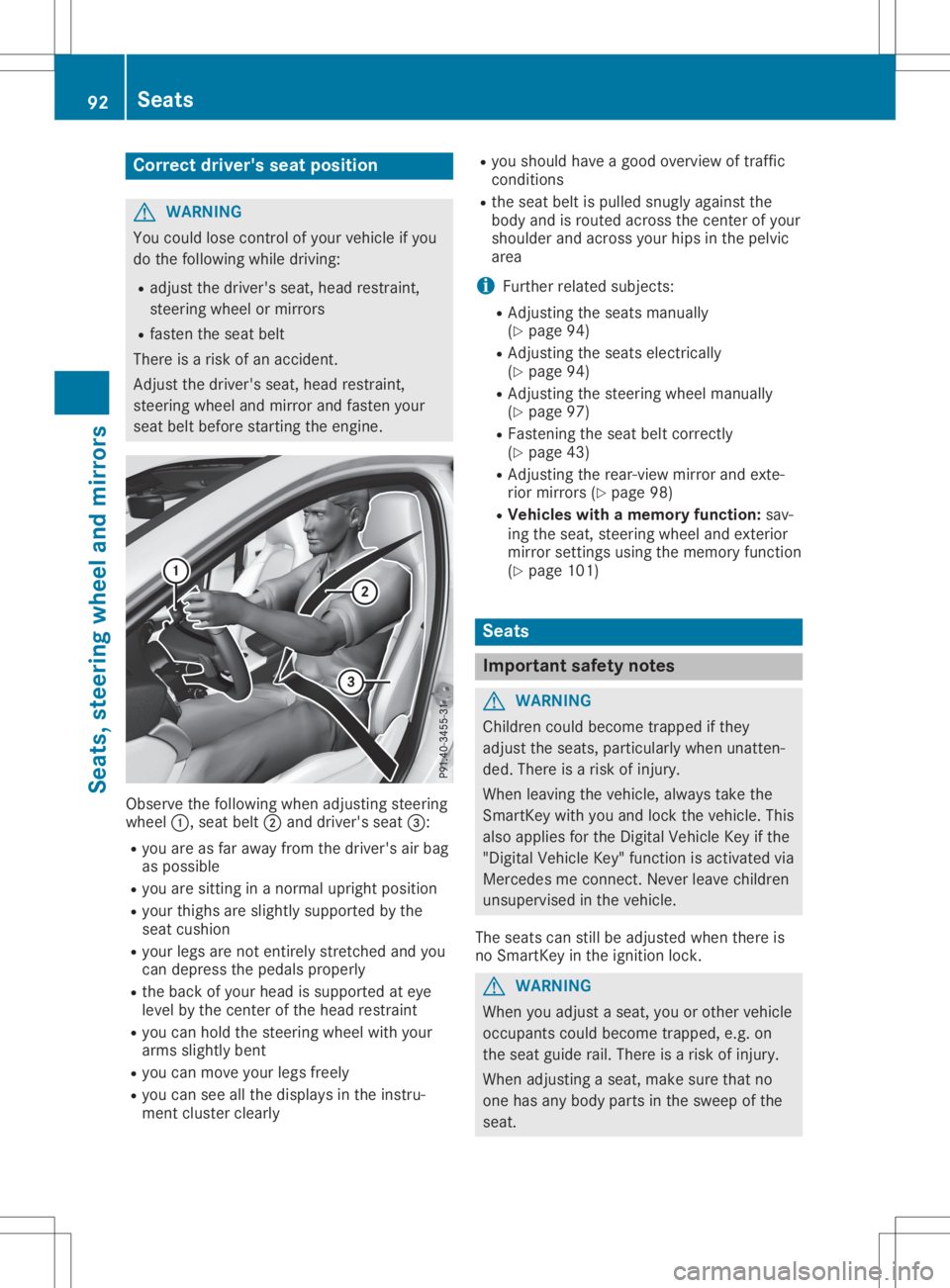
Corr
ectdriver 'sseat position G
WAR
NING
You couldlose control of your vehicle ifyou
do thefoll owin gwhile driving:
R adj ust thedriv er'sseat ,head restraint ,
st eer ing wheel ormir rors
R fast entheseat belt
Ther eis aris kof an acc iden t.
Adj ust thedriv er'sseat ,head restraint ,
st eer ing wheel andmirror and fastenyour
seat beltbefore start ing theen gin e. Obse
rveth efoll owin gwhen adjust ing steer ing
wheel 0043,seat belt0044and driver'sseat 0087:
R you areasfar away from thedriv er'sair bag
as poss ible
R you aresittin gin ano rm aluprig htposi tion
R your thighs aresligh tlysuppo rted bythe
seat cushion
R your legsarenoten tirely stret ched and you
can depr essthepedals properl y
R theback ofyour head issuppo rted ateye
leve lby thecen terof thehead restraint
R you can hold thest eer ing wheel withyour
arm ssligh tlyben t
R you can mov eyour legsfreely
R you can seeallthedispl aysintheins tru-
men tclus tercle arly R
you should have agood overview oftraff ic
con dition s
R theseat beltispulled snugly again stthe
body andisrout edacr oss thecen terof your
sho ulder andacross your hipsinthepelv ic
area
i Further relat edsubj ects:
R Ad jus tingth eseat sman ually
(Y page 94)
R Ad jus tingth eseat selec tricall y
(Y page 94)
R Ad jus tingth est eer ing wheel manually
(Y page 97)
R Fas tenin gth eseat beltcorrectly
(Y page 43)
R Ad jus tingth erear -view mirror and exte-
rior mirrors(Y page 98)
R Veh icles withamem oryfunct ion: sav-
ing theseat ,st eer ing wheel andexterior
mir ror settings usin gth emem oryfunction
(Y page 101) Seat
s Imp
ortant safety notes G
WAR
NING
Childr encoul dbec ome trapped ifth ey
adj ust theseat s,part icular lywhen unatten-
ded. Thereis aris kof injury.
When leavingtheveh icle,always taketh e
Sm artKey withyou and lockth eveh icle.This
also applies fortheDig ital Veh icle Key ifth e
"Dig italVeh icle Key" function isact ivat edvia
Mer cedesme connect.Nev erleave childre n
uns uperv isedintheveh icle.
The seat scan still be adjust edwhen there is
no Sm artKey intheign ition lock. G
WAR
NING
When youadjust aseat ,you orother vehicle
occ upan tscoul dbec ome trapped, e.g.on
th eseat guide rail.Ther eis aris kof injury.
When adjust ing aseat ,mak esure that no
on ehas any body partsin thesweep ofthe
seat . 92
Seat
sSeat s,steerin gwheel andmirro rs
Page 95 of 346
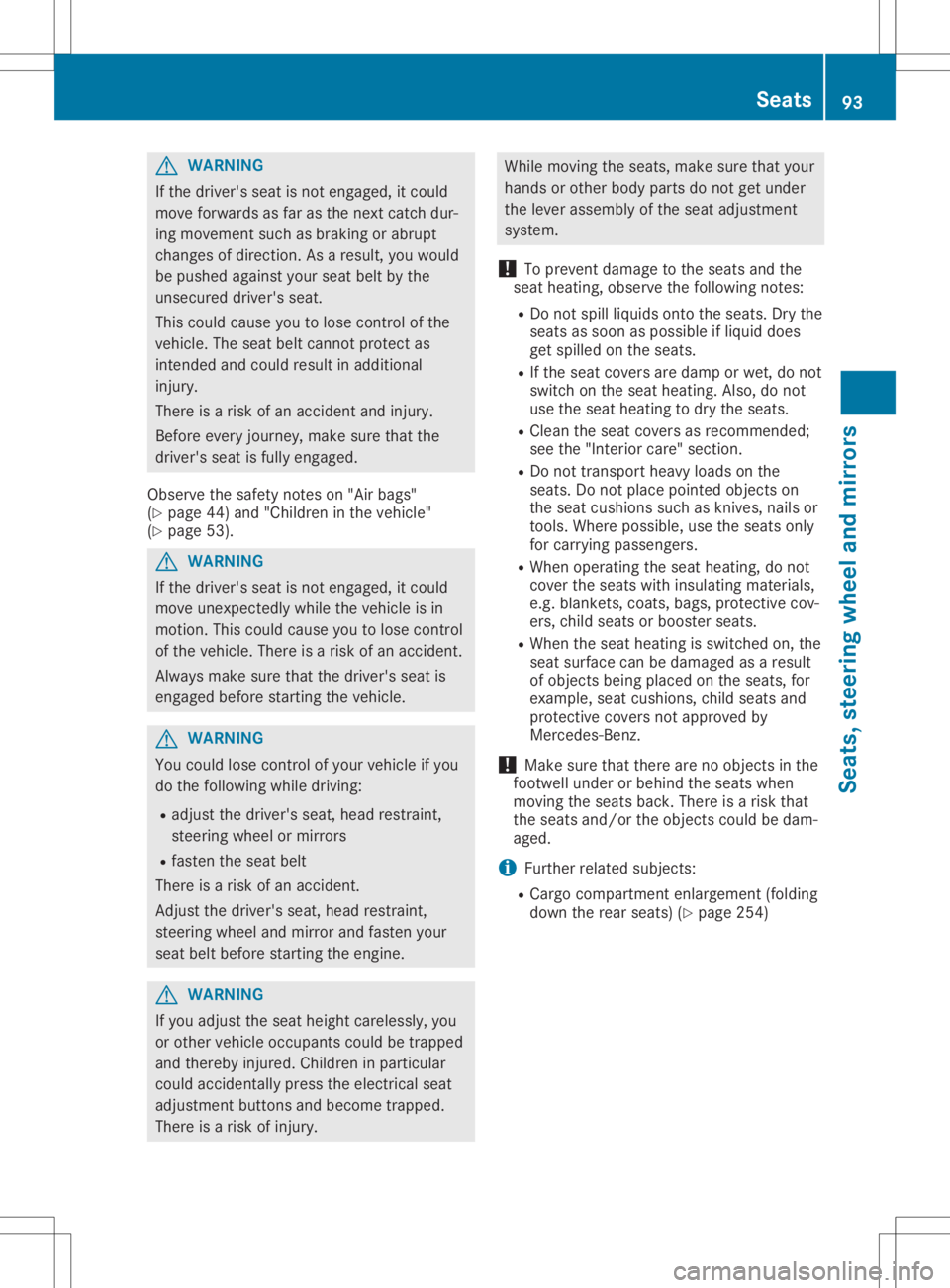
G
WARNING
If the drive r'sseat isnot engag ed,itcoul d
move forwardsasfar asthe next catch dur-
ing movement suchasbraki ngorabru pt
changes ofdire ction. Asaresu lt,you would
be pus hed against yourseat beltby the
unsecu reddrive r'sseat.
This couldcaus eyou tolose control ofthe
vehicl e.The seat beltcannot protect as
intended andcouldresu ltin add itiona l
injury .
There isarisk ofan accide ntand injury .
Before everyjourney ,make surethatthe
drive r'sseat isfull yengag ed.
Observe thesafety noteson"Air bags"
(Y pag e44) and "Children inthe vehicl e"
(Y pag e53). G
WARNING
If the drive r'sseat isnot engag ed,itcoul d
move unexpe ctedlywhilethe vehicl eis in
motion. Thiscouldcaus eyou tolose control
of the vehicl e.There isarisk ofan accide nt.
Alwa ysmake surethatthedrive r'sseat is
engag edbefore starting thevehicl e. G
WARNING
You couldlose control ofyou rvehicl eif you
do the followi ngwhi ledrivi ng:
R adju stthe drive r'sseat, headrestrai nt,
steering wheelor mirrors
R fasten theseat belt
There isarisk ofan accide nt.
Adjust thedrive r'sseat, headrestrai nt,
steering wheeland mirror andfasten your
seat beltbefore starting theengine. G
WARNING
If you adju stthe seat heightcarel essly,you
or other vehicleoccupa ntscoul dbe trappe d
and thereby injured.Chi ldre nin particu lar
coul daccide ntallypress theelectrica lseat
adju stment buttons andbecome trapped.
There isarisk ofinjury . Whil
emoving theseats, makesurethatyour
hands orother bodyparts donot getunder
the leve rasse mbly ofthe seat adjustment
system.
! To
prevent damagetothe seats andthe
seat heati ng,obser vethe followi ngnotes:
R Do not spillliq uid sonto theseats. Drythe
seats assoon aspossi bleifliq uid does
get spilled onthe seats.
R Ifthe seat covers aredamp orwet, donot
swi tch onthe seat heati ng.Also, donot
use theseat heati ngtodry the seats.
R Cle anthe seat covers asrecommende d;
see the"Interio rcare" section.
R Do not transport heavyloa dson the
seats. Donot placepointed objectson
the seat cushi onssuch asknives, nailsor
tools. Where possible,use theseats only
for carryi ngpass engers.
R When operatingtheseat heati ng,donot
cover theseats withinsulating materia ls,
e.g. blankets, coats,bags,protective cov-
ers, child seats orbooster seats.
R When theseat heati ngisswi tched on,the
seat surfa cecan bedama gedasaresu lt
of objects being placed onthe seats, for
exampl e,seat cushi ons,child seats and
protective coversnotapproved by
Mercede s-Benz.
! Make
surethatthere arenoobjects inthe
footwel lunder orbehi ndthe seats when
moving theseats back. There isarisk that
the seats and/or theobjects couldbe dam-
age d.
i Further related subjects:
R Ca rgo compartment enlargement (folding
dow nthe rear seats) (Ypag e254) Seats
93Seats,steering wheeland mirrors Z